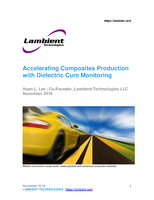ASTM approves traffic intersection movement data standard.
Press Release Summary:
ASTM International Committee E17 on Vehicle-Pavement Systems has approved E2667, Practice for Acquiring Intersection Turning Movement Traffic Data, which standardizes how to compile and interpret data regarding traffic turning through intersections. Developed by Subcommittee E17.52 on Traffic Monitoring, this standard could impact future environmental and safety decisions regarding intersection geometry and traffic control.
Original Press Release:
ASTM Approves First Standard for Traffic Intersection Movement Data
W. CONSHOHOCKEN, Pa., 4 June 2009-Being able to compile and interpret data on how traffic turns through an intersection could have an impact on future environmental and safety decisions regarding intersection geometry and traffic control. However, until recently no standard has existed to properly obtain and use this data. Now, ASTM International Committee E17 on Vehicle-Pavement Systems has approved E2667, Practice for Acquiring Intersection Turning Movement Traffic Data, a new standard developed by Subcommittee E17.52 on Traffic Monitoring.
"Intersections that do not work well constrain the flow of vehicles and induce higher risk taking because of increased delay," says Ralph Gillmann, a team leader for the Federal Highway Administration and chair, Subcommittee E17.52. "Within an urban area, intersections commonly have the highest incidence of accidents. Vehicle idling increases emissions and reduces air quality. Improvements to traffic operations, safety and air quality are directly related to understanding and improving vehicle movement at intersections."
Making improvements to intersections requires the consistent and repeatable monitoring of vehicles at intersections. "While there are standards for monitoring vehicles passing road segments, there was no standard for monitoring vehicle movements at intersections," says Gillmann. "Through ASTM, this first standard practice for intersection turning movements has been adopted."
The benefits of understanding vehicle turning movement data are widespread. "If we are concerned about reducing air pollution, improvements to how an intersection accommodates traffic is important because vehicle delays impact pollution," says David Albright, transportation surety program manager, Bernalillo County Public Works Division, and a longtime E17 member. "If we are concerned about safety, accidents are compared with exposure rates and exposure rates are based on traffic data. Something that appears to be as simple as counting cars, trucks, pedestrians and bicycles at intersections turns out to be critical to our health and well-being."
According to Albright, the importance of the data and the constraints imposed by the current practice led to the development of the new standard. "ASTM E2667 is the first intersection vehicle turning movement standard and it continues the tradition of ASTM leadership in traffic data standards."
Albright notes that there are two ways in which the absence of a standard practice negatively impact intersection operations and safety. "One way is in the limitation of comparing data within an organization over time. The second way is the limitation of comparing data at the same point in time among different organizations."
Data managers who supervise intersection turning movement data collection and the people who collect this data will be the primary users of E2667, while the beneficiaries of it will be decision makers who use the data to make intersection improvements, and ultimately the public.
ASTM International standards are available from Customer Service (phone: 610-832-9585; service@astm.org) or at www.astm.org.
For technical information, contact David P. Albright, Bernalillo County Public Works Division, Albuquerque, N.M. (phone: 505-848-1516; dpalbright@bernco.gov). ASTM Committee E17 meets Dec. 7-9 during December committee week in Atlanta, Ga.
ASTM International welcomes and encourages participation in the development of its standards. ASTM's open consensus process, using advanced Internet-based standards development tools, ensures worldwide access for all interested individuals. For more information on becoming an ASTM member, please contact Daniel Smith, ASTM International (phone: 610-832-9727; dsmith@astm.org).
Established in 1898, ASTM International is one of the largest international standards development and delivery systems in the world. ASTM International meets the World Trade Organization (WTO) principles for the development of international standards: coherence, consensus, development dimension, effectiveness, impartiality, openness, relevance and transparency. ASTM standards are accepted and used in research and development, product testing, quality systems and commercial transactions around the globe.




